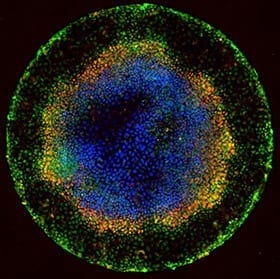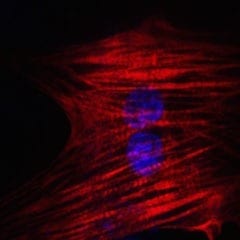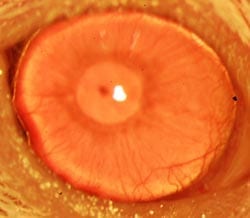“It brings us closer to the possibility of replacement organs grown in petri dishes and wounds that can be swiftly healed.”
About seven days after conception, something remarkable occurs in the clump of cells that will eventually become a new human being. They start to specialize. They take on characteristics that begin to hint at their ultimate fate as part of the skin, brain, muscle or any of the roughly 200 cell types that exist in people, and they start to form distinct layers.
Although scientists have studied this process in animals, and have tried to coax human embryonic stem cells into taking shape by flooding them with chemical signals, until now the process has not been successfully replicated in the lab. But researchers led by Ali Brivanlou, Robert and Harriet Heilbrunn Professor and head of the Laboratory of Stem Cell Biology and Molecular Embryology at The Rockefeller University, have done it, and it turns out that the missing ingredient is geometrical, not chemical.
“Understanding what happens in this moment, when individual members of this mass of embryonic stem cells begin to specialize for the very first time and organize themselves into layers, will be a key to harnessing the promise of regenerative medicine,” Brivanlou says. “It brings us closer to the possibility of replacement organs grown in petri dishes and wounds that can be swiftly healed.”
Read more . . .
The Latest on: Replacement organs
[google_news title=”” keyword=”Replacement organs” num_posts=”10″ blurb_length=”0″ show_thumb=”left”]
via Google News
The Latest on: Replacement organs
- SeaStar Medical Announces $3.6 Million NIH Grant Award to Study the Selective Cytopheretic Device in Adult Patients with Severe Chronic Heart Failureon April 30, 2024 at 5:30 am
DENVER, April 30, 2024 (GLOBE NEWSWIRE) -- (Nasdaq: ICU), a medical device company developing proprietary solutions to reduce the consequences of hyperinflammation on vital organs, announces that the ...
- Oldest operating pipe organ in Beaver County featured in May concert of beloved hymnson April 30, 2024 at 1:22 am
Kearney will play both the 1838 Joseph Harvey and 1928 Eskey organs of the church. During the 90-minute concert, he will play familiar hymns that date back 100 years. The concert precedes the ...
- Xi Is Taking a Page Out of Mao's Playbook—Waging War to Protect Himself at Home | Opinionon April 29, 2024 at 6:44 am
Xi, in effect, is creating large, formidable, and durable coalitions against his China. For instance, in 2021, Australia, the U.K., and the U.S. formed AUKUS, and Japan may soon sign on. Japan and the ...
- Organ shortage: Surgeons are saving human lives with pig kidneyson April 26, 2024 at 9:29 pm
Surgeons at NYU Langone Health renowned academic medical center lin New York, have performed the world's first combined heart pump and gene-edited pig kidney transplant on a woman with end-stage ...
- Go 4 It -- Breaking the Myths: Organ donation and misinformationon April 26, 2024 at 7:56 pm
With over 100,000 people waiting for a life-saving transplant, it is crucial to dispel the myths and provide accurate information about the benefits of organ donation.
- N.Y. can boost organ donation rates & save liveson April 25, 2024 at 10:00 pm
April is Donate Life Month, an opportunity to celebrate those who generously gave the gift of life through organ and tissue donation and the triumphant stories of people who received a lifesaving ...
- Mike Pinder, Moody Blues co-founder and keyboardist, dies months after bandmate Denny Laineon April 25, 2024 at 7:27 pm
Pinder, the last original member of the band, sang and played keyboards, as well as organ, piano and harpsichord. He founded the British band in 1964 with Laine, Ray Thomas, Clint Warwick and Graeme ...
- Henry Ford Health surgeon emphasizes importance of organ transplants in minority communitieson April 24, 2024 at 5:35 pm
DETROIT – April is Donate Life Month, an opportunity to educate everyone about the importance of the gift of life.
- 5 families of inmates say university took their loved ones’ organs ‘without consent’on April 19, 2024 at 7:57 am
BIRMINGHAM, Ala. (WBRC/Gray News) - Five Alabama families have filed lawsuits claiming the University of Alabama at Birmingham’s Department of Pathology removed the organs from dead inmates at ...
- The danger of turning ‘brain death’ and organ donation into culture war issueson April 18, 2024 at 12:13 pm
Medical science, for all the hope of health and life it offers to many, also presents certain critical issues that need to be examined in the light of a discerning anthropological and ethical ...
via Bing News











